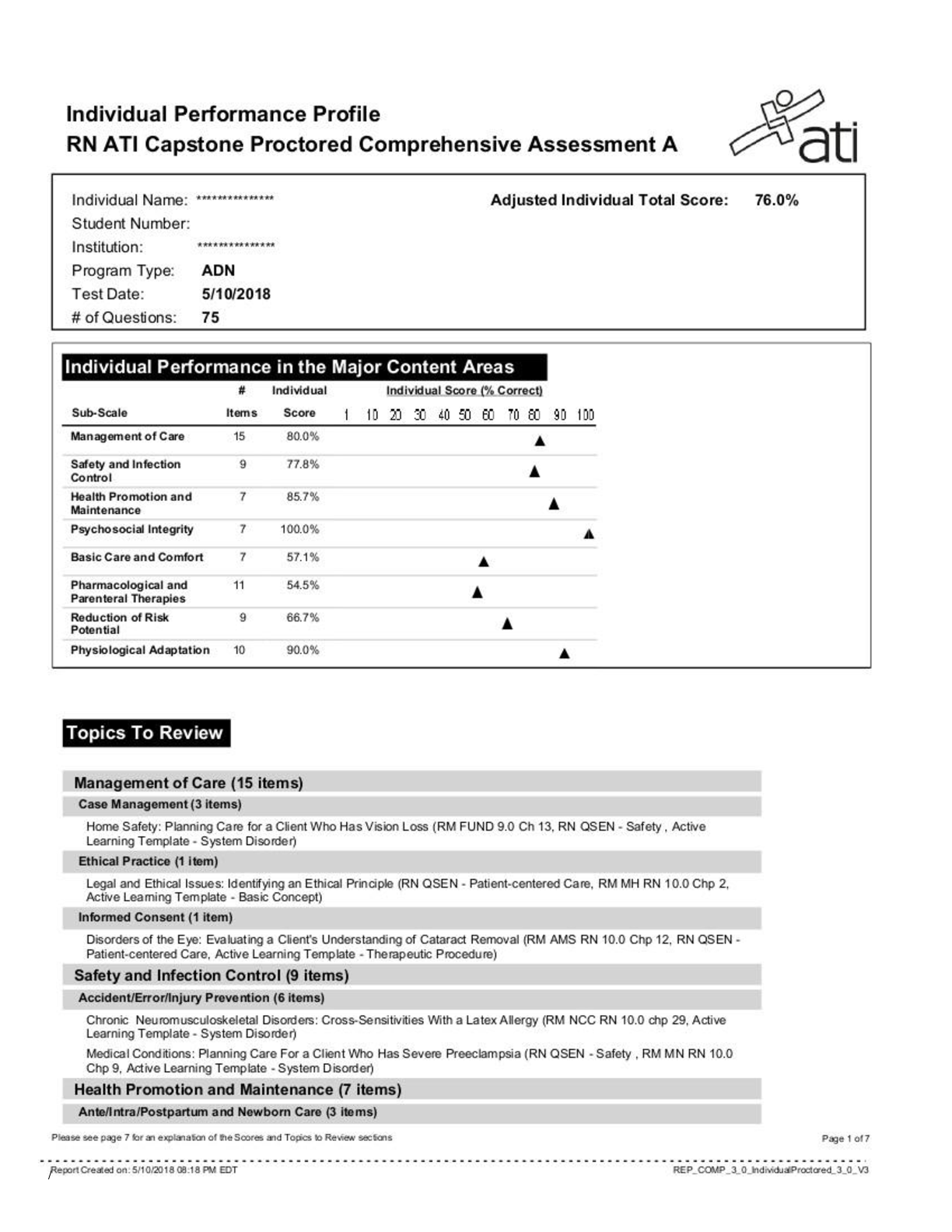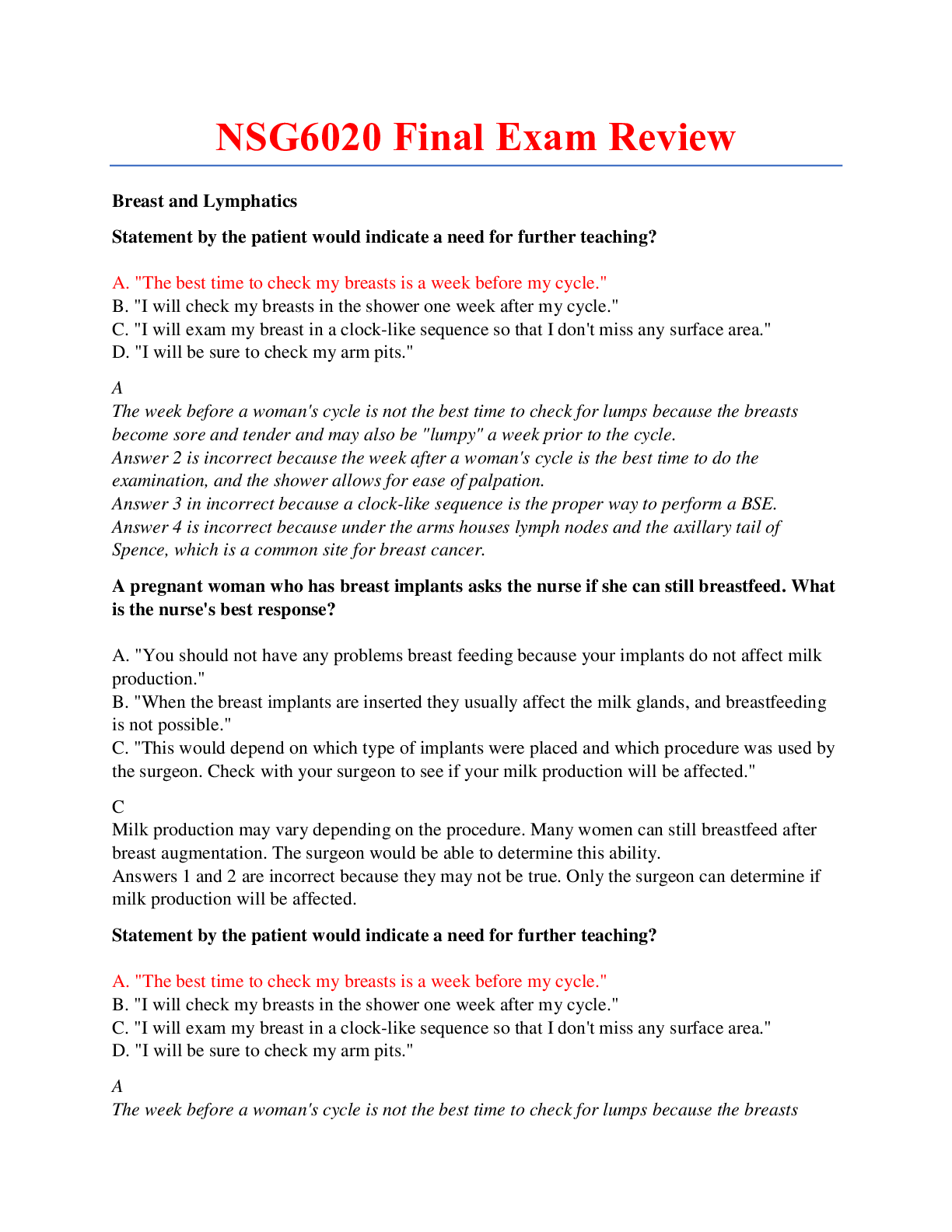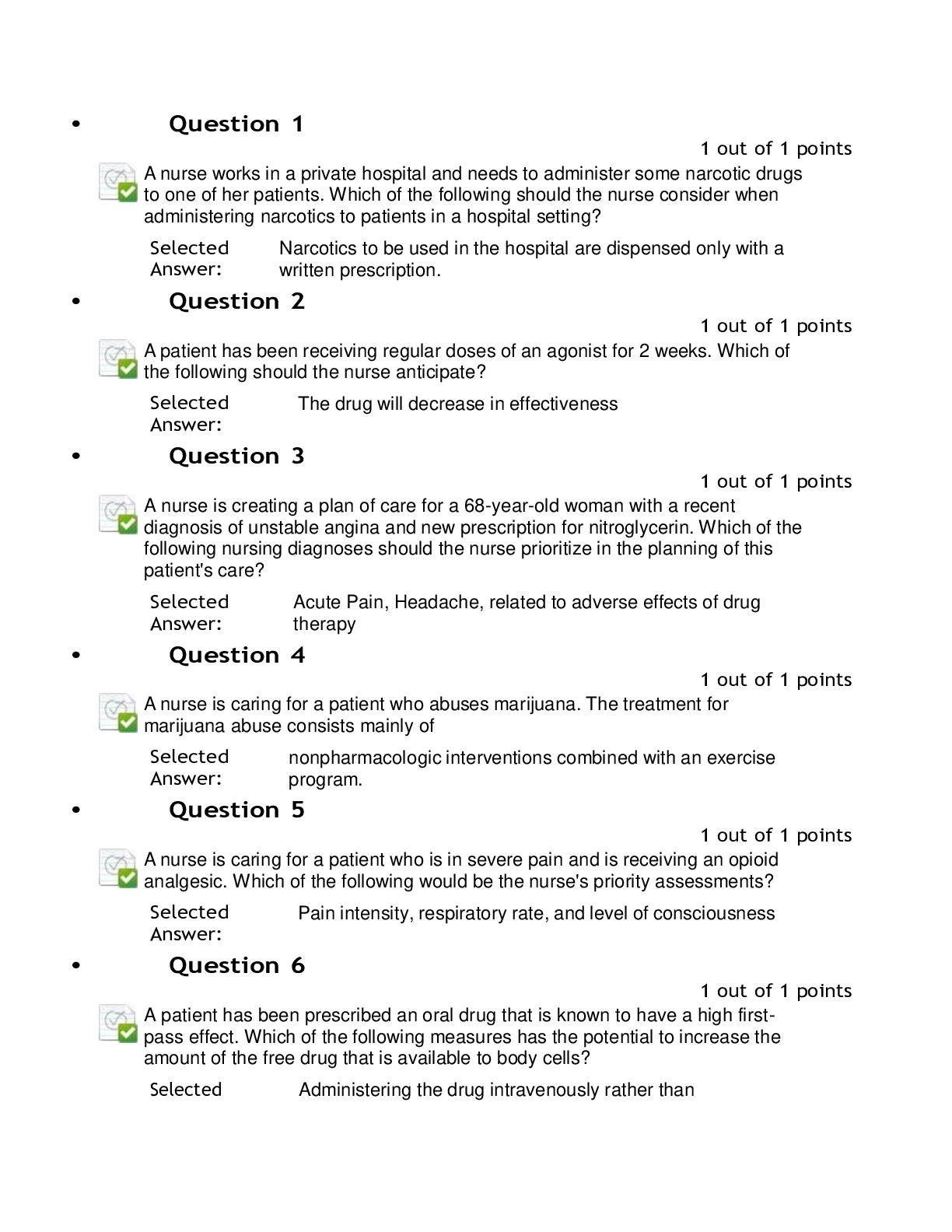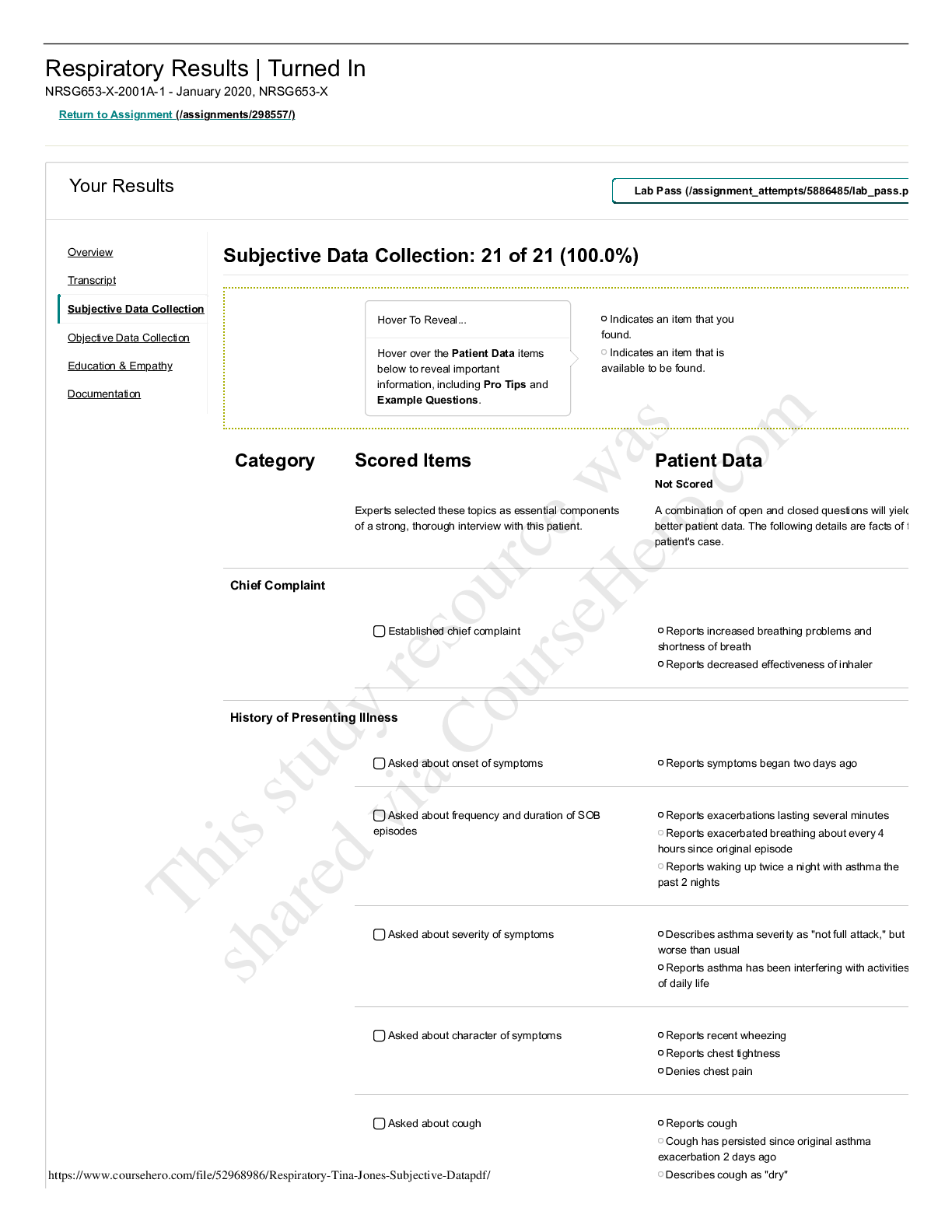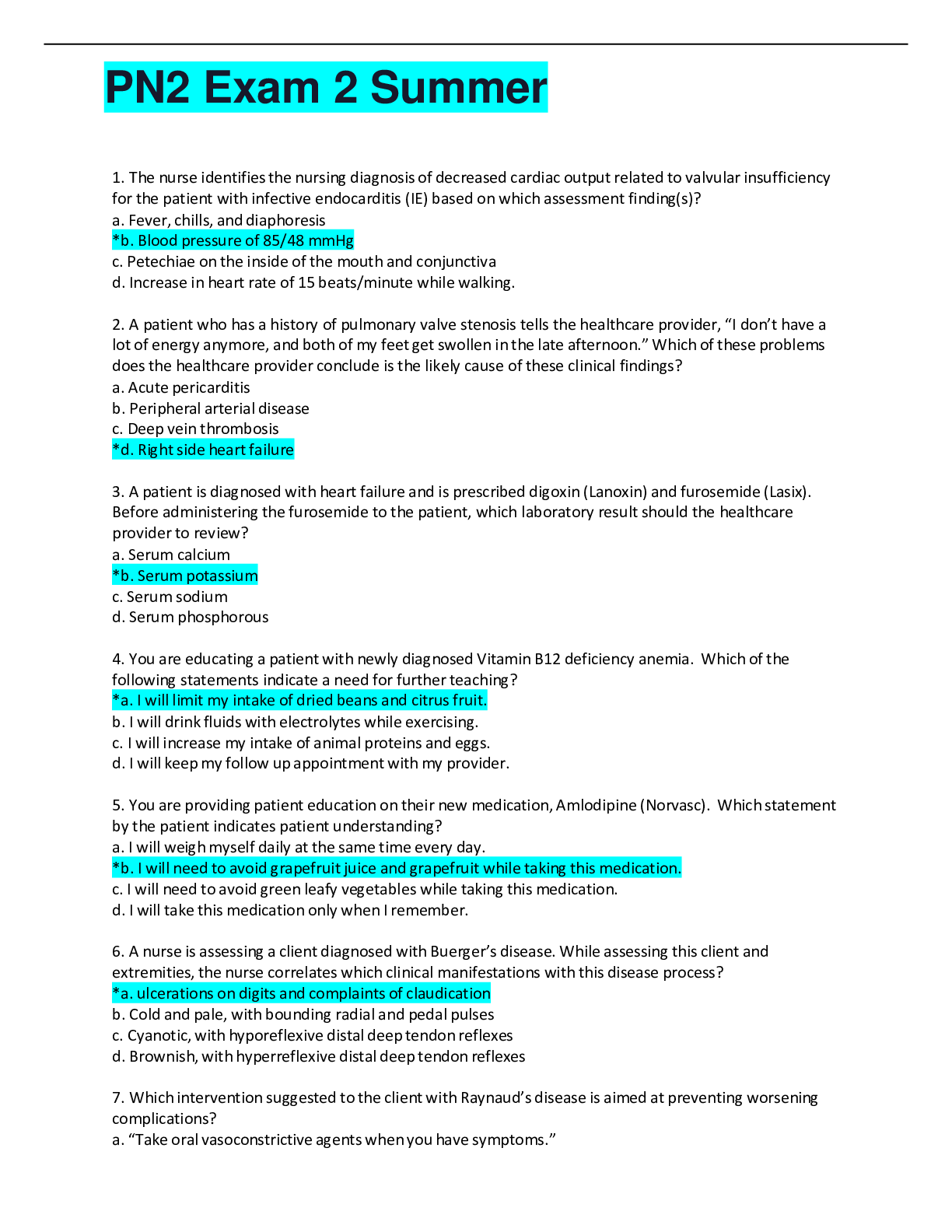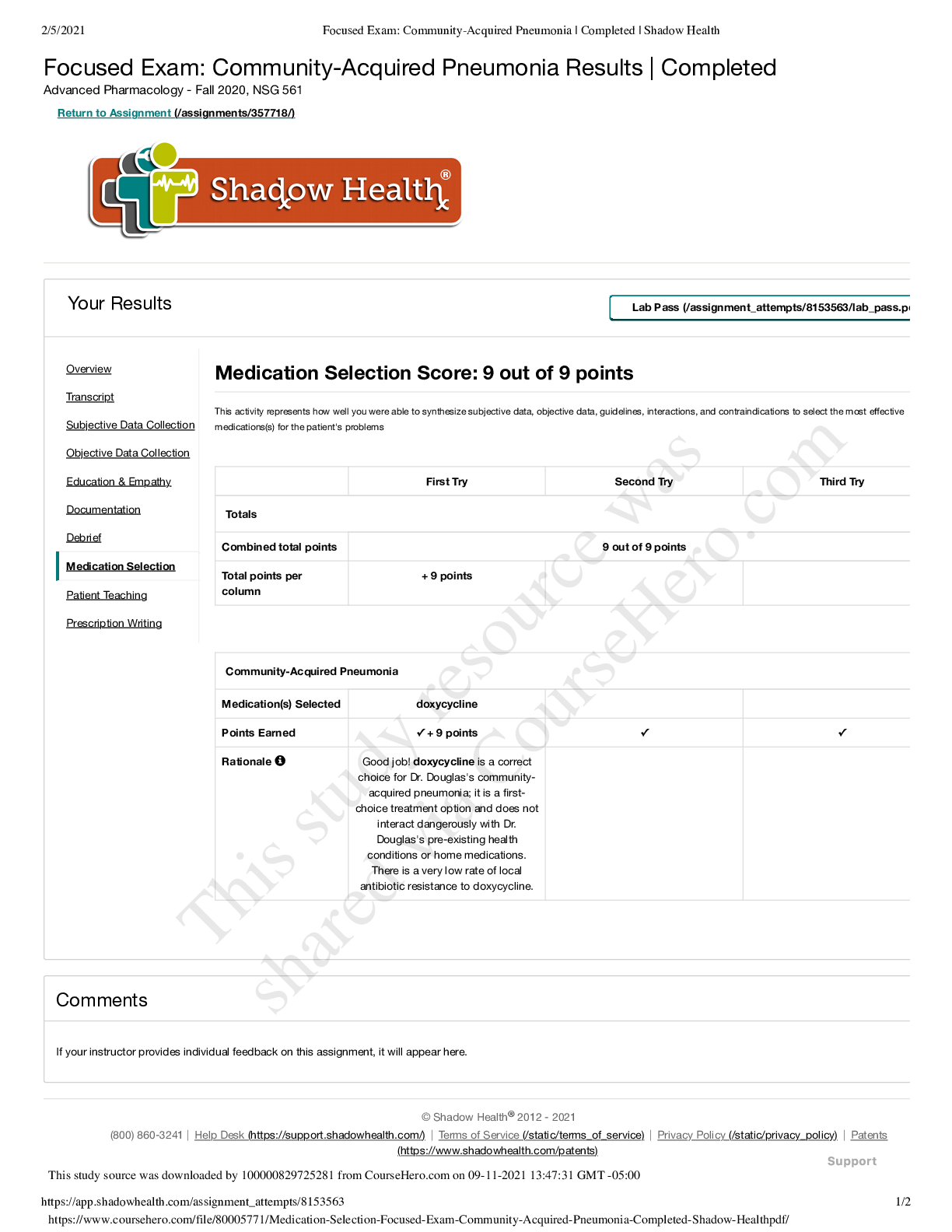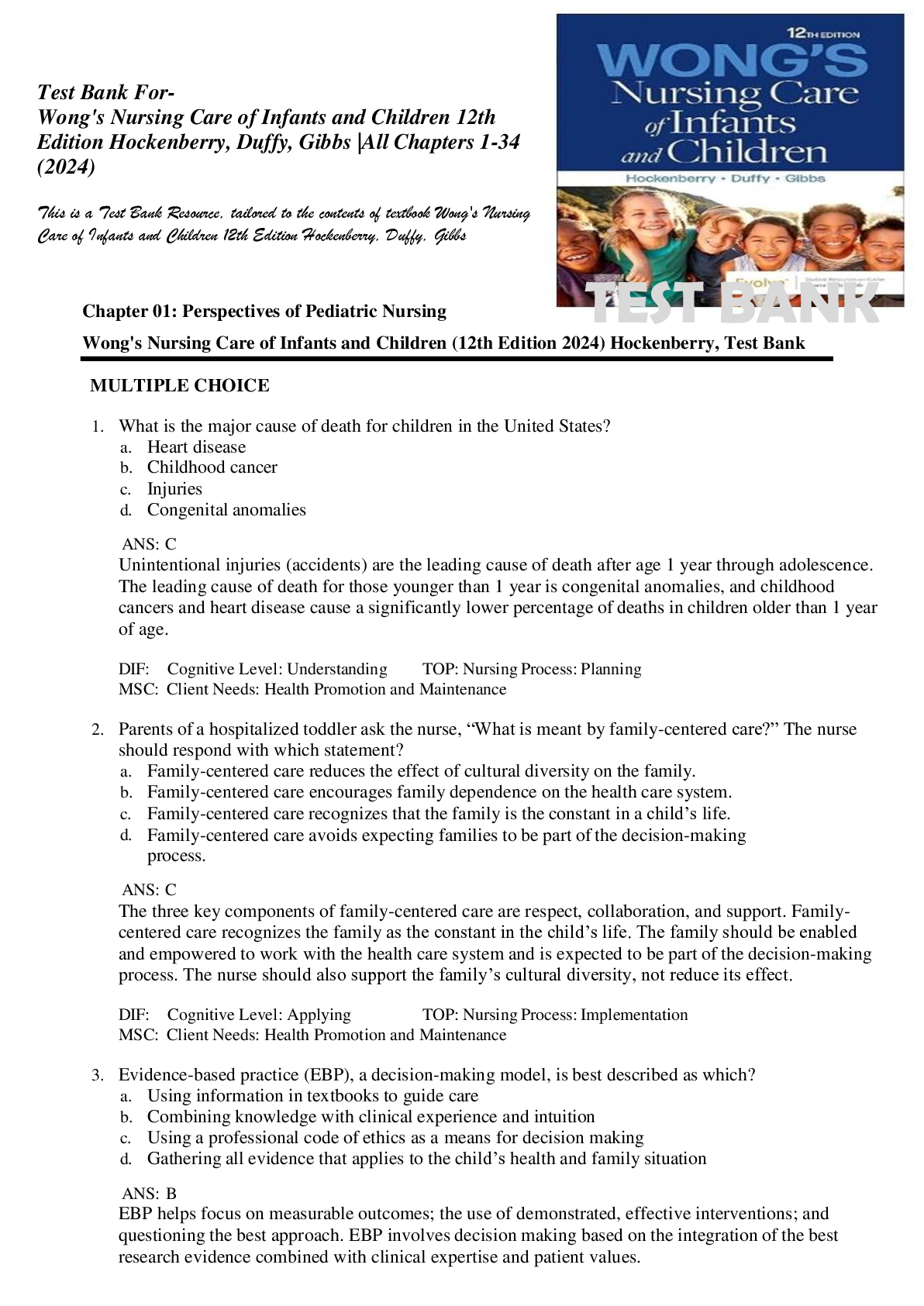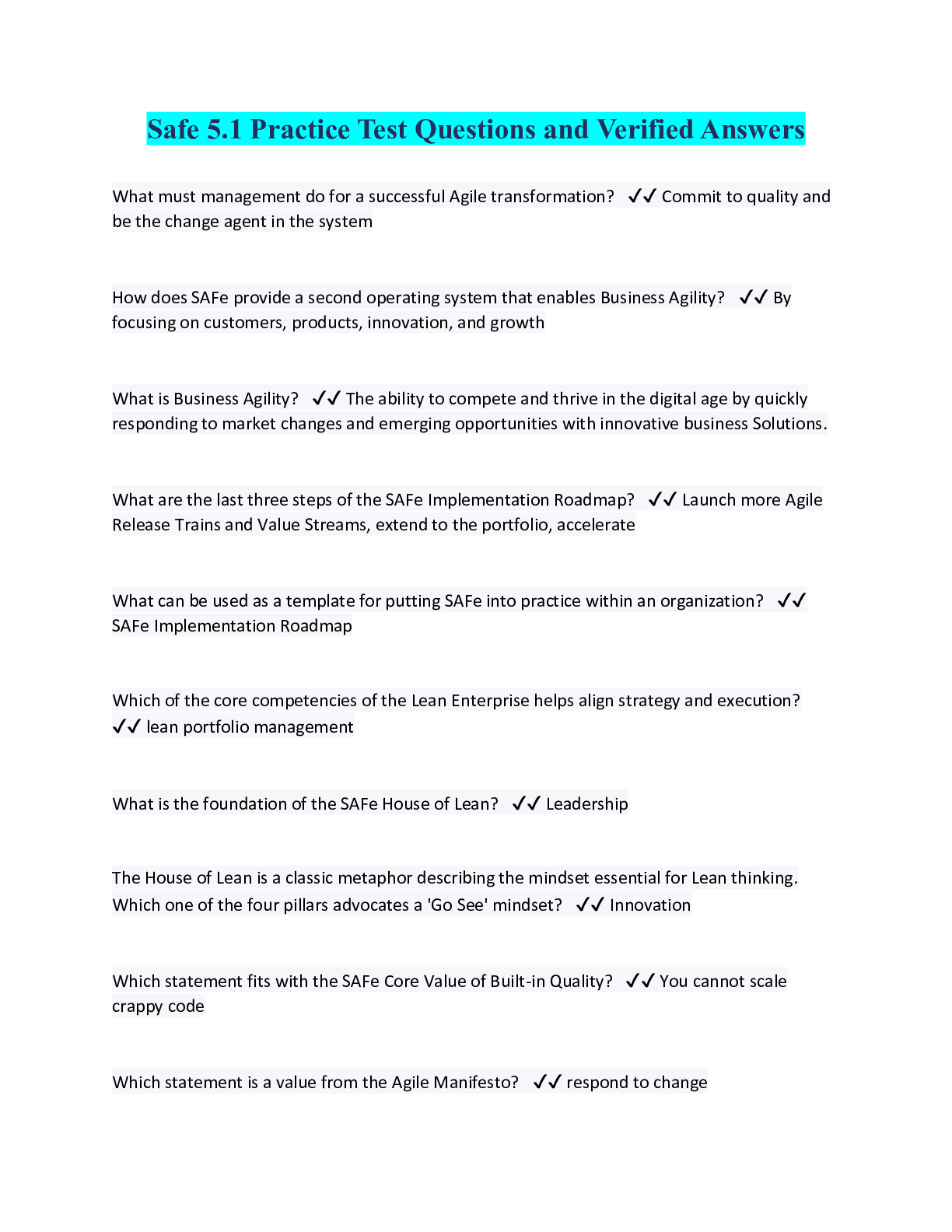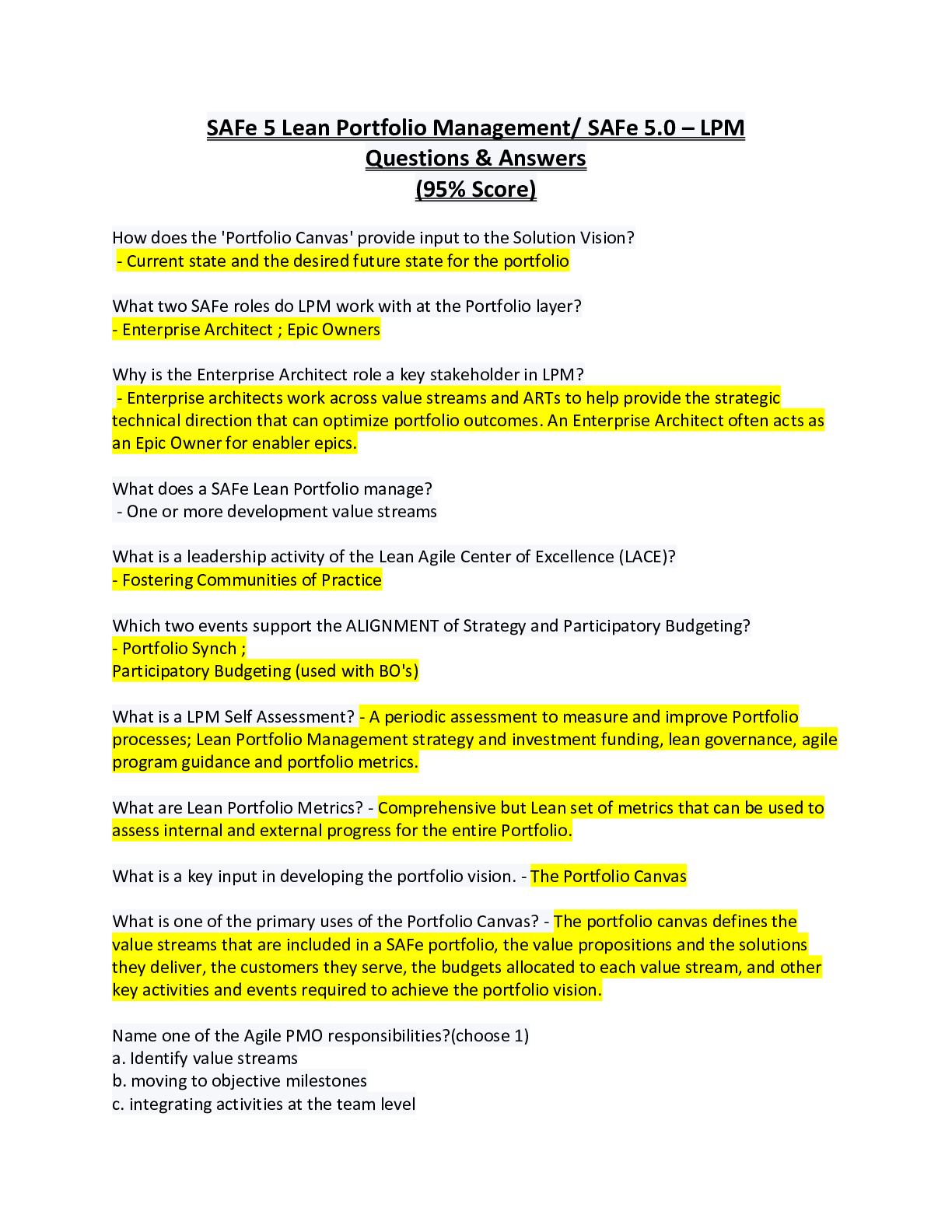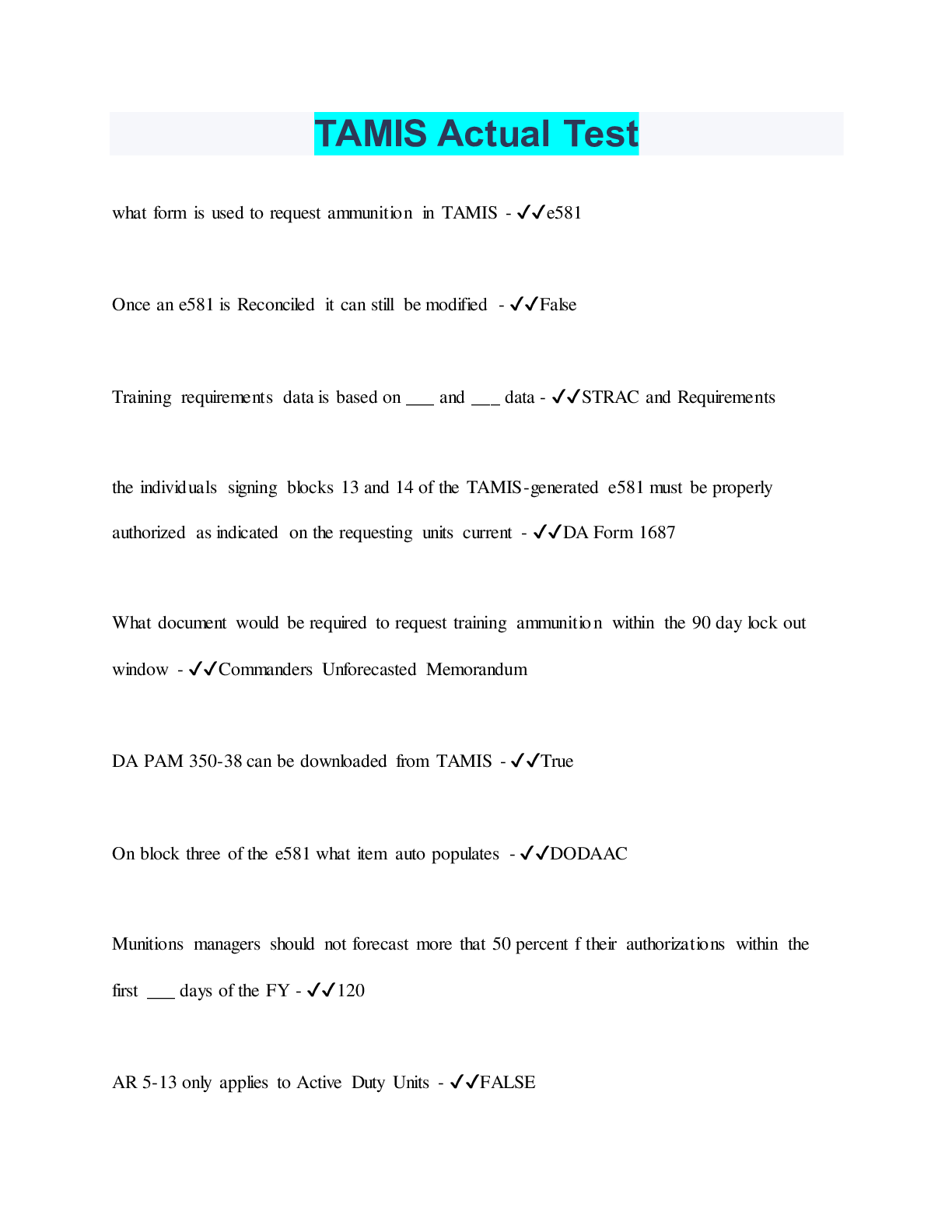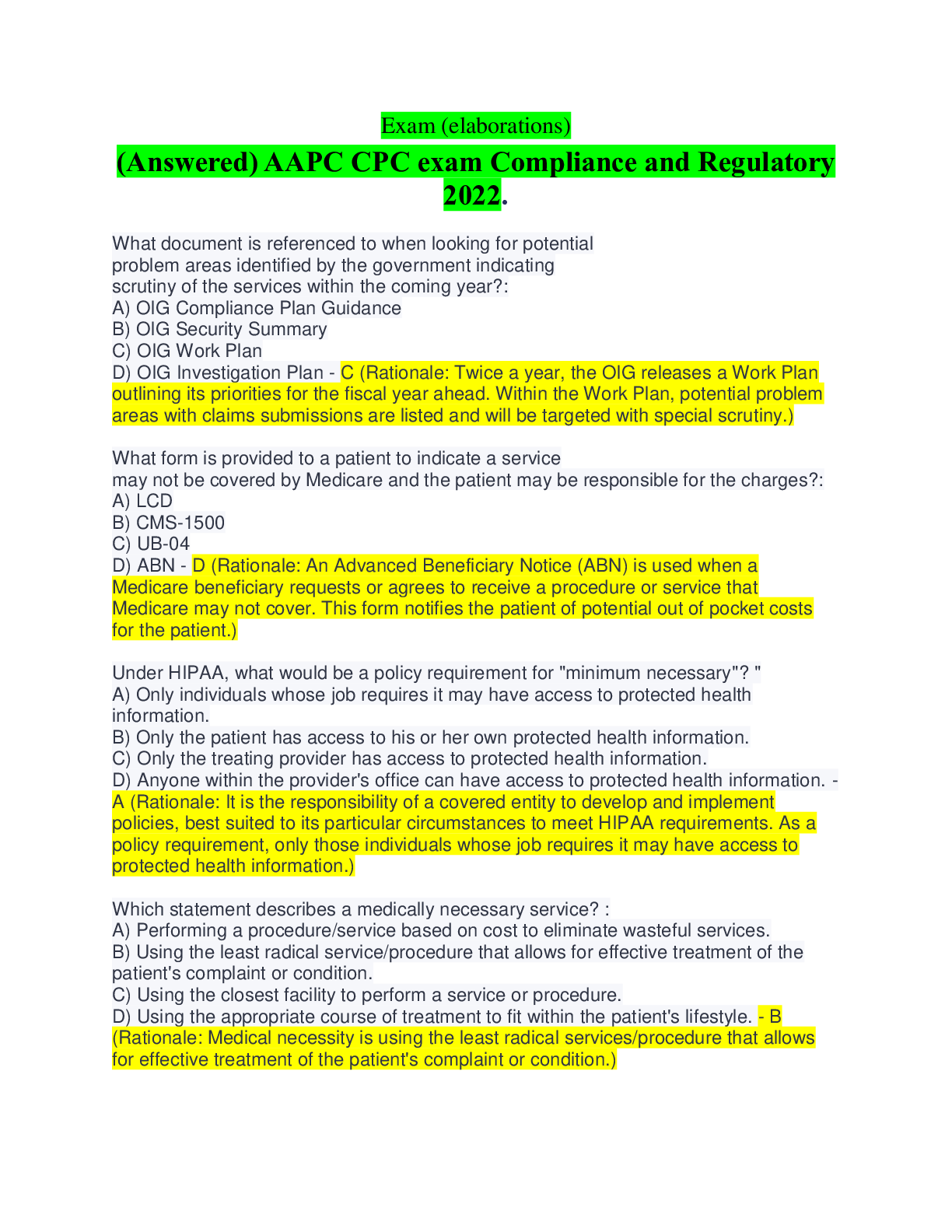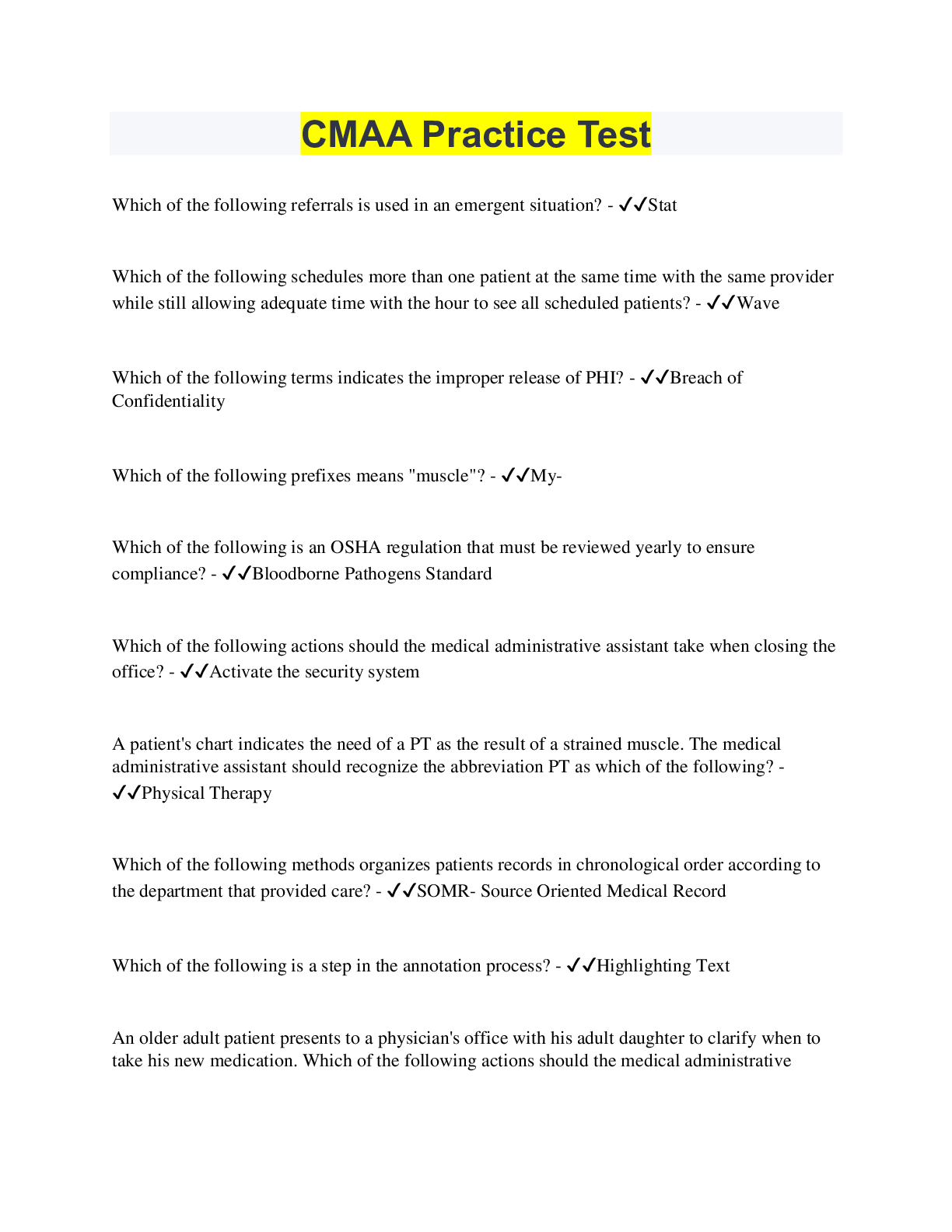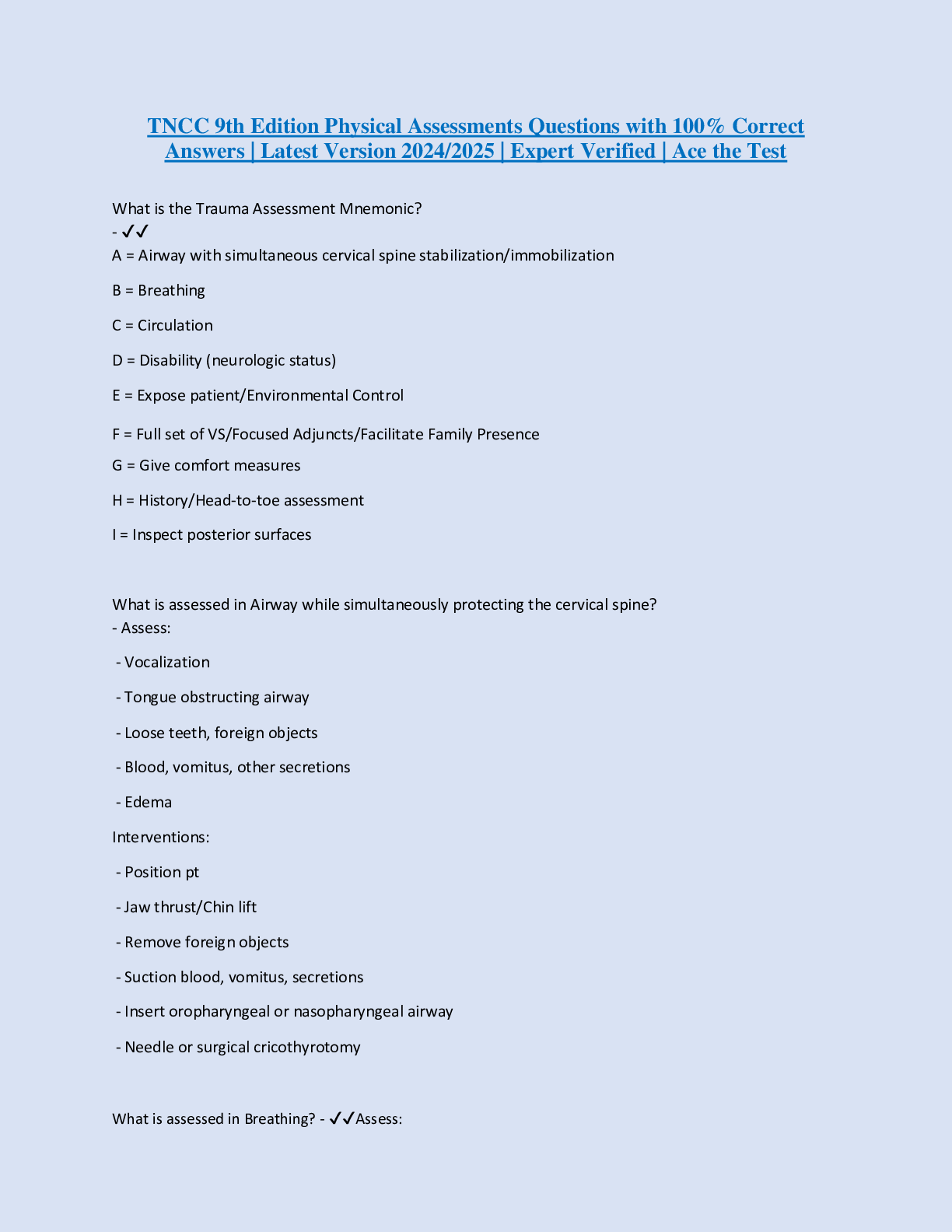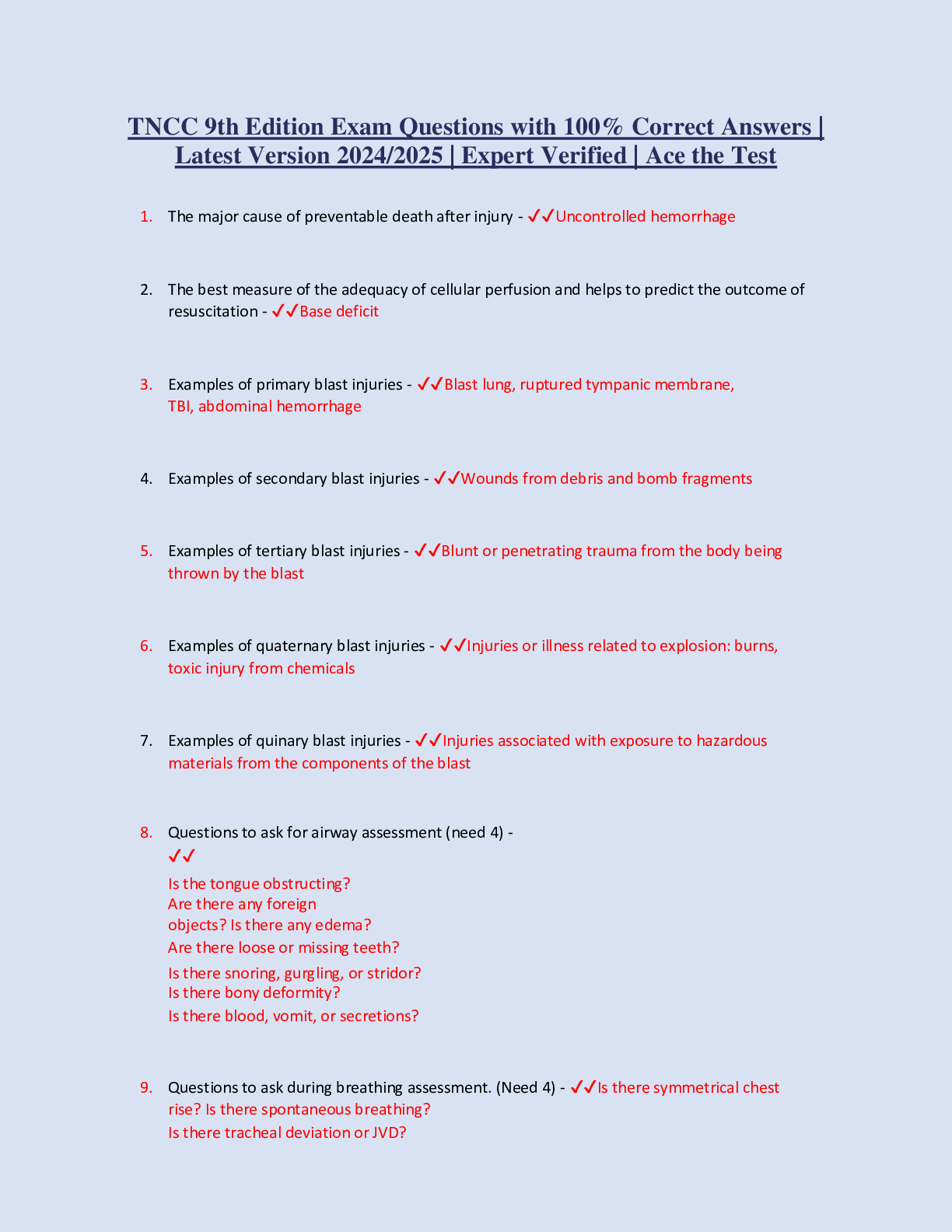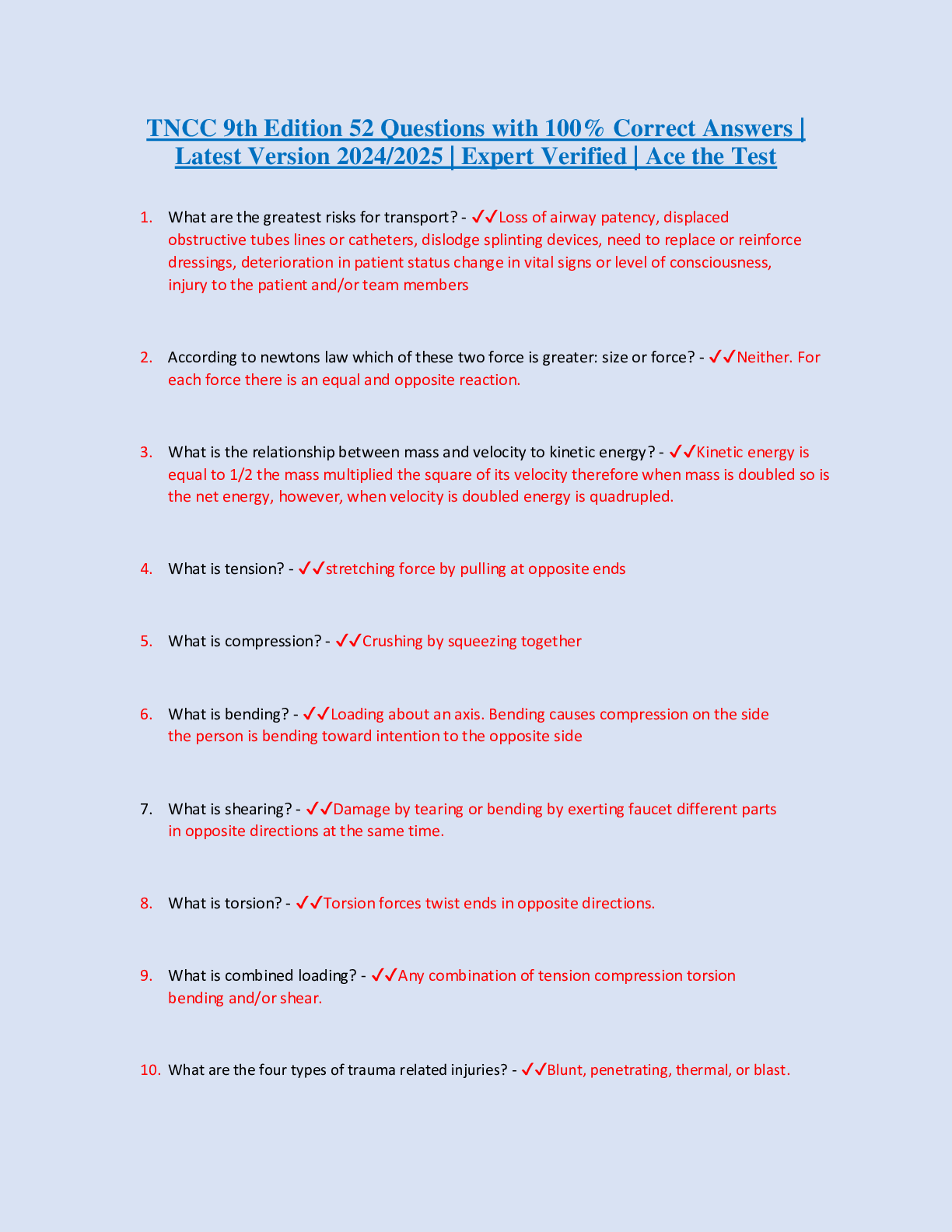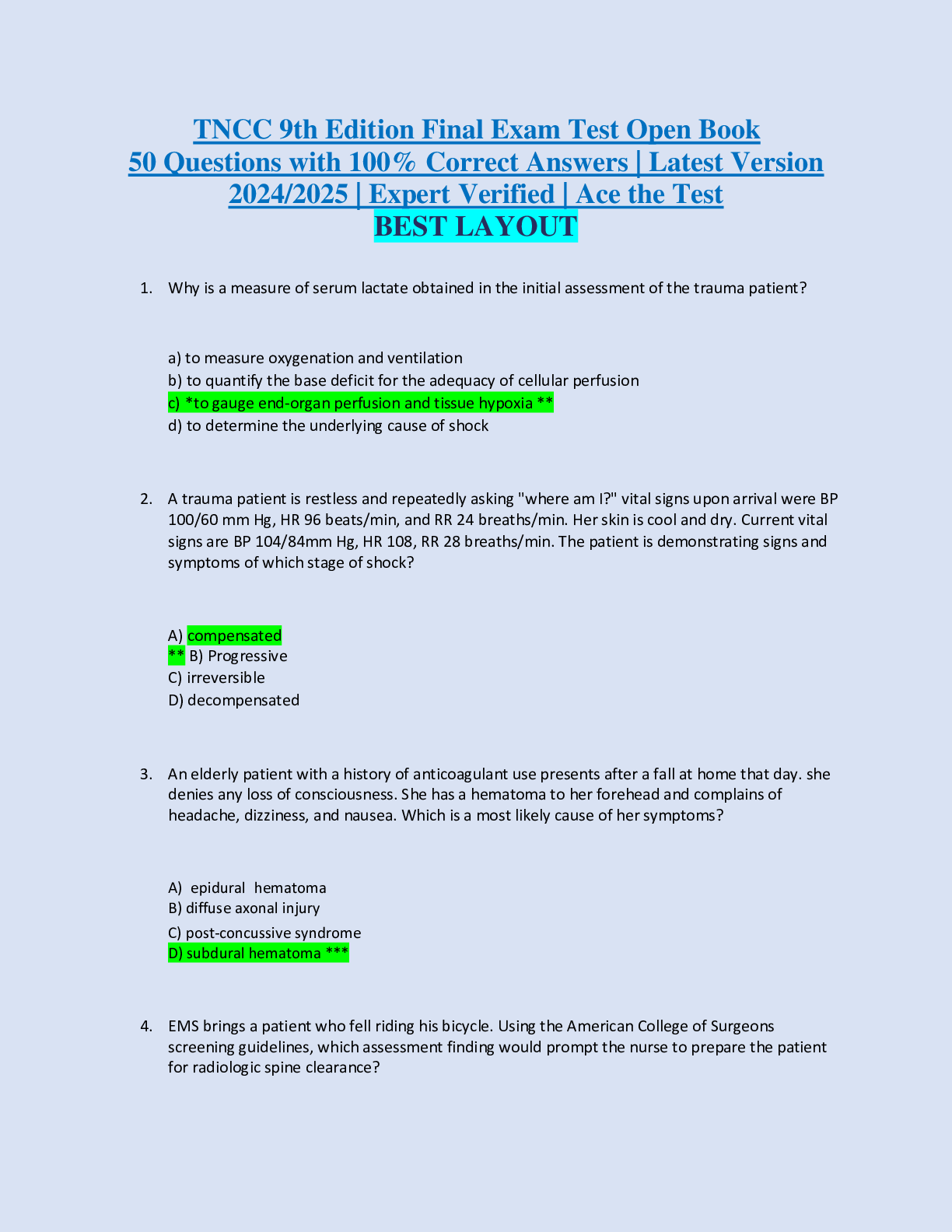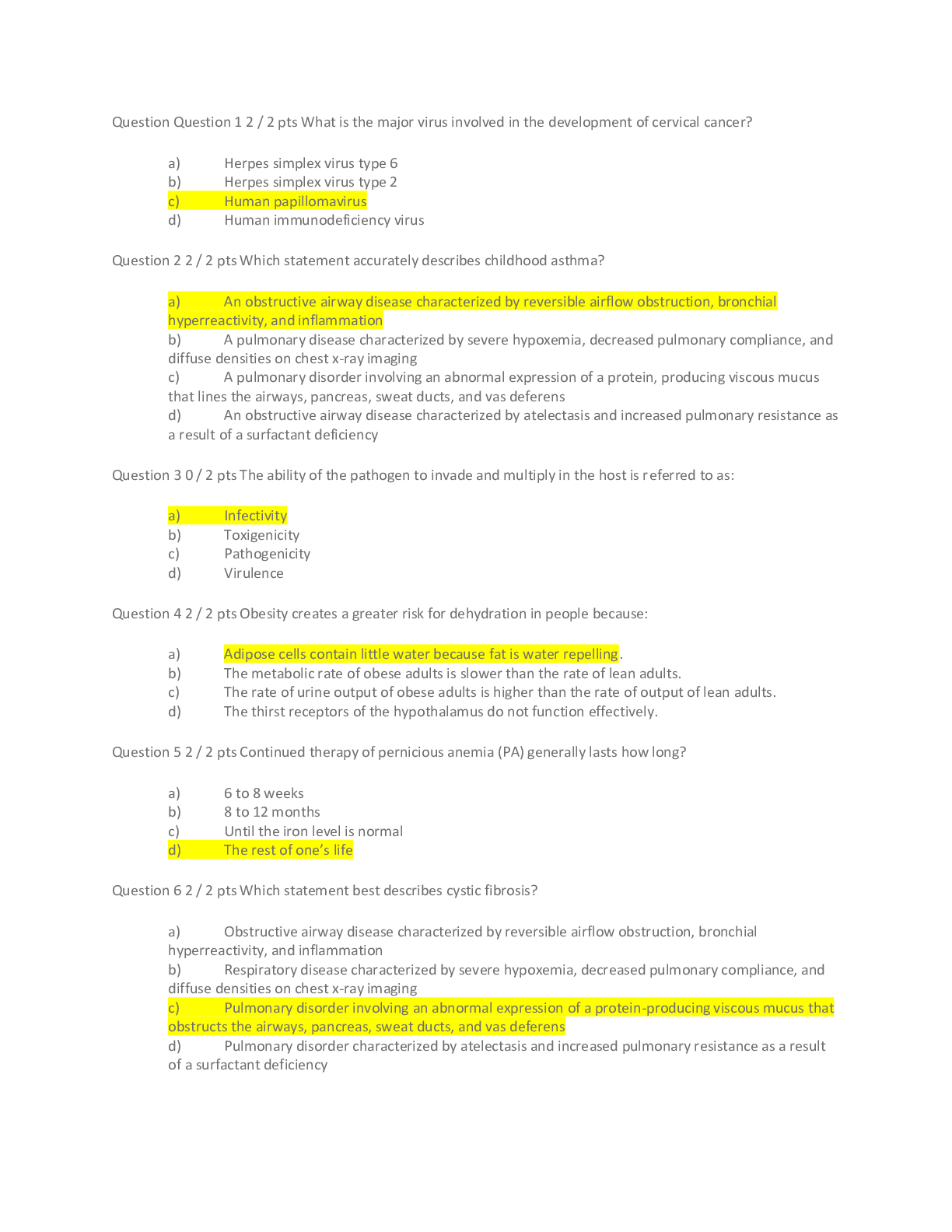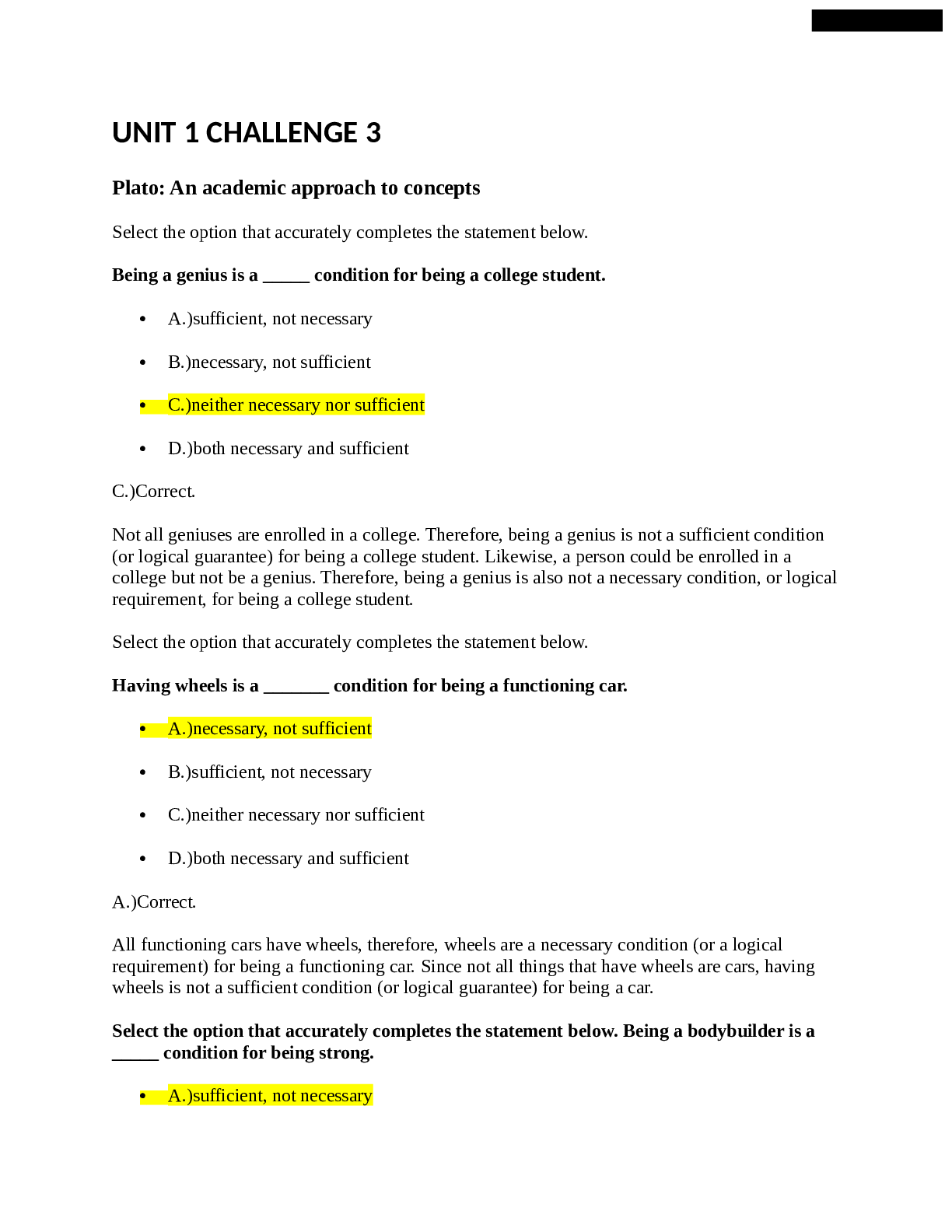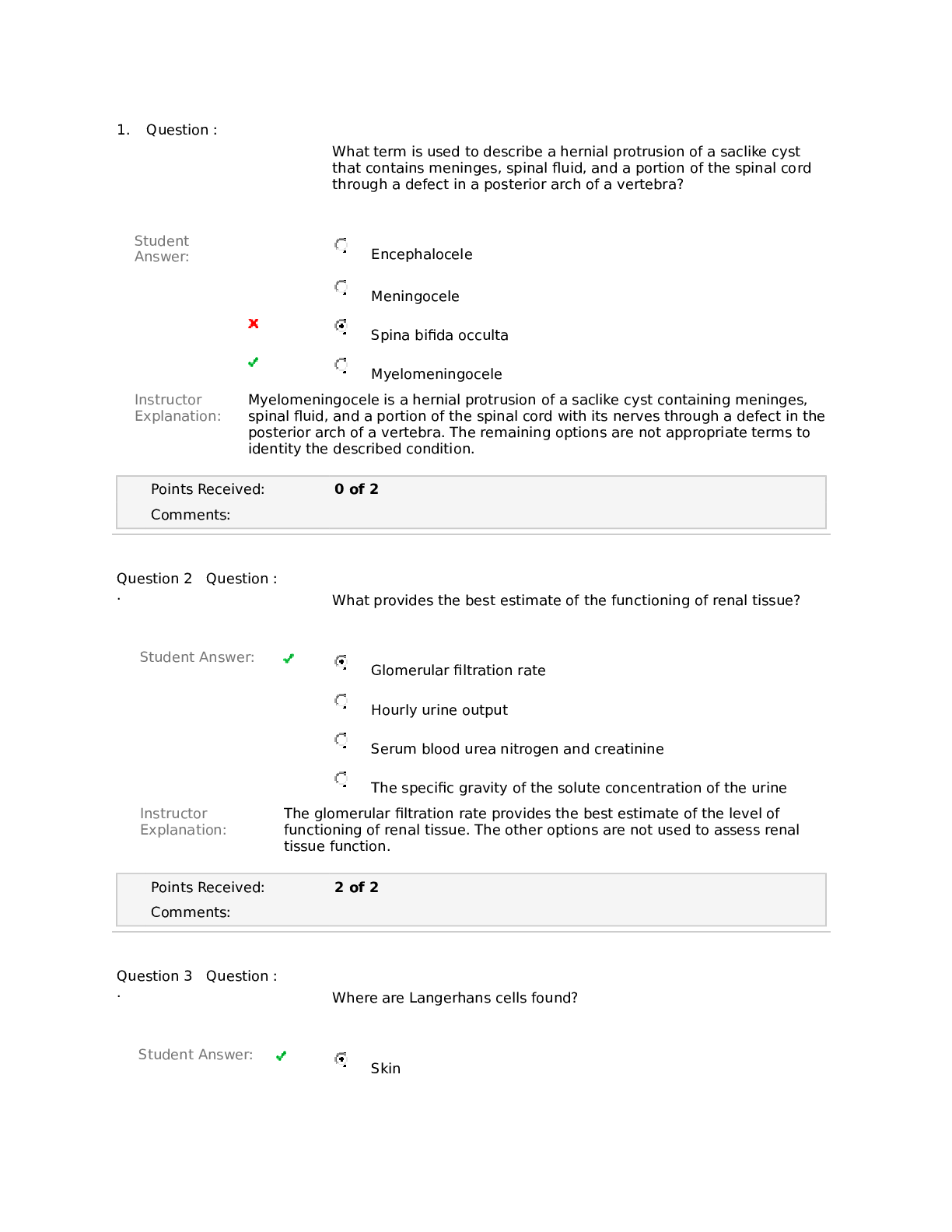Health Care > EXAM > UC Course Portal ▶︎ SP(1) ▶︎ BS in Health Sciences ▶︎ HSCI320 Med Sociology (001) SP1 (All)
UC Course Portal ▶︎ SP(1) ▶︎ BS in Health Sciences ▶︎ HSCI320 Med Sociology (001) SP1 ▶︎ Week 1 ▶︎ Quiz 1. Grade 29 out of 30 (97%)
Document Content and Description Below
UC Course Portal ▶︎ SP(1) ▶︎ BS in Health Sciences ▶︎ HSCI320 Med Sociology (001) SP1 ▶︎ Week 1 ▶︎ Quiz 1 Question 1 In Mark 0 out of 1 Question 2 Unlike infectious ... diseases, chronic diseases typically are _____________ and _ Select one: a. Short term; incurable. b. Short term; curable. c. Long term; incurable. d. Long term; curable. e. There is no difference. Page: 11 Long term; incurable. People who become infected with HIV may be subjected to discrimination, whic social outcome is: Select one: a. Stigma. b. Stagflation. c. Disintegration. d. Disentanglement. e. All of the above. Page: 42 Stigma. QUIZ NAVIGATION Show one page at a time Finish review 1 2 3 4 5 6 7 8 9 10 11 12 13 14 15 16 17 18 19 20 21 22 23 24 25 26 27 28 29 30 Question 3 Question 4 Question 5 Which circumstance(s) particularly affected the development of medical sociolo Select one: a. Pressure to produce work that could be applied to medical practice and h b. Rich development of theories unique to medical sociology by academic s c. Lack of attention on the role of medicine and health from classical theoris d. A and B e. A and C Page: 3 A and C Which is NOT a major area of investigation in medical sociology? Select one: a. Social facets of health and disease. b. Social behavior of health care personnel and their patients. c. Social functions of health organizations and institutions. d. The relationship of health care delivery systems to other systems. e. All of the above answers are major areas of investigation in medical socio Page: 1 All of the above answers are major areas of investigation What is NOT a task of a sociologist in medicine? Select one: a. Analyze the social etiology or causes of health disorders b. Study the differences in social attitudes as they relate to health c. Understand the way in which the incidence and prevalence of a specific h variables. d. Develop theory that assists in understanding social issues related to heal e. All of these are tasks of a sociologist in medicine. Page: 5 Develop theory that assists in understanding social issue Question 6 Question 7 Question 8 Which of the following is TRUE about incidence and prevalence? Select one: a. Prevalence is used to analyze the rate at which new cases occur. b. Incidence and prevalence are interchangeable terms. c. Incidence is reported in raw numbers while prevalence is expressed as a d. The incidence for a given disease can be low at the same time that its pre e. None of the above Page: 24 The incidence for a given disease can be low at the sam The germ theory of disease is a perspective which asserts: Select one: a. Diseases are caused by a biological agent. b. Medicine is the only true way to treat disease. c. Illness can be caused by lifestyle choices. d. Germs are conscious agents that intentionally harm their hosts. e. None of the above. Page: 10-11 Diseases are caused by a biological agent. As a nation shifts from primarily rural-agricultural to urban-industrial, what chang of the nation? Select one: a. Leading causes of death change from mostly chronic diseases to infectio b. Leading causes of death change from mostly infectious diseases to chron c. Infectious diseases are eliminated entirely d. Both infectious and chronic diseases are reduced to a minimum. e. There is no difference Page: 29 Leading causes of death change from mostly infectious d Question 9 Question 10 Question 11 Which of the following demonstrates the sociological implications of the HIV/AID Select one: a. Its influence on modifying social norms, values, and lifestyles. b. How certain social behaviors lead to the transmission of the disease and c. The social rejection of AIDS patients. d. Moral and religious debates over the meaning of the disease and treatme e. All of the above. Page: 43 All of the above. The World Health Organization defines health as: Select one: a. Normality. b. The absence of disease. c. Ability to function. d. A state of complete physical, mental, and social well-being e. All of the above. Page: 7 A state of complete physical, mental, and social well-bein The current public policy approach to dealing with AIDS is: Select one: a. Through banning high-risk behaviors. b. Through mandatory universal testing. c. Through quarantine of infected individuals. d. Through safe-sex education. e. None of the above. Page: 43 Through safe-sex education. Question 12 Question 13 Question 14 Which of the following are TRUE about health lifestyles? Select one: a. They include behaviors like smoking, drinking, and alcohol consumption. b. They influence whether and how severely one becomes ill. c. They can be positive or negative. d. They are influenced by one’s social environment. e. All of the above. Page: 12 All of the above. A ratio, such as the crude mortality rate, is expressed as: Select one: a. Total number of cases divided by prevalence. b. Total number of cases divided by incidence. c. Total number of cases divided by total population. d. Total number of cases times total population. e. Total number of cases times incidence. Page: 24-25 Total number of cases divided by total population. The lowest AIDS mortality rates for American males are found in: Select one: a. Native Americans. b. Non-Hispanic whites. c. Hispanics. d. Non-Hispanic African Americans. e. Asians. Page: 39 Asians. Question 15 Question 16 Question 17 With the transition to a greater prevalence of chronic diseases, physicians have approach to medical care? Select one: a. The clinical gaze. b. Use of “magic bullets.” c. “Whole person” care. d. The re-mystification of disease. e. Assembly-line care. Page: 11 “Whole person” care. What do studies on diet, exercise, and obesity suggest with respect to heart dis Select one: a. Diet and physical activity have little effect on an individual’s likelihood of d b. Changing one’s eating habits toward a diet low in saturated fat can reduc disease. c. Obesity is the result of individual choices and relates little to the developm d. Only lengthy, vigorous physical activity has been shown to provide some e. None of the above. Page: 31-35 Changing one’s eating habits toward a diet low in satura developing heart disease. The Hippocratic Oath requires the physician to swear that he or she will: Select one: a. Help the sick. b. Refrain from intentional wrongdoing or harm. c. Keep confidential all matters pertaining to the doctor–patient relationship. d. All of the above. e. None of the above. Page: 8 All of the above. Question 18 Question 19 Question 20 What is the leading cause of death in the United States, accounting for more tha Select one: a. Diabetes. b. HIV/AIDS. c. Stroke. d. Heart disease. e. Cancer. Page: 30 Heart disease. At the end of 2007, the majority of AIDS cases in the U.S. were found in: Select one: a. Homosexual and bisexual men. b. Homosexual and bisexual women. c. Intravenous drug users. d. Blood transfusion patients. e. Children of a parent with AIDS. Page: 38 Homosexual and bisexual men. What trend(s) reduced tensions between sociologists in medicine and sociologi Select one: a. Most government funding is awarded to research with practical applicatio b. Medical sociology itself is converging with general sociology. c. Sociology of medicine became the more dominant side of medical sociolo d. A and B e. B and C Page: 5-6 A and B Question 21 Question 22 Question 23 Decline in deaths from infectious diseases in the second half of the nineteenth c Select one: a. Improvements in diet, housing, and public sanitation. b. Better training of physicians. c. The discovery of penicillin. d. Epidemiological transitions. e. All of the above. Page: 10 Improvements in diet, housing, and public sanitation. The primary focus of the epidemiologist is on: Select one: a. Catastrophic disease outbreaks. b. Societal demographics. c. Health and wellness of children. d. Individual’s diseases. e. Health problems of social aggregates. Page: 23 Health problems of social aggregates. The medicine of social spaces is concerned with: Select one: a. Curing disease. b. Preventing disease. c. Understanding disease. d. Cataloging disease. e. All of the above. Page: 9 Preventing disease. Question 24 Question 25 Question 26 In the case of the sick role, illness is seen as __________, and its undesirable n be healthy. Select one: a. Deviance. b. Normal. c. Biological. d. Social. e. A stimulus. Page: 4 Deviance. _________________ has special significance for a society because it is traditio indicator of a society’s standard of living and quality of health care delivery. Select one: a. Prevalence of chronic diseases. b. Life expectancy. c. Infant mortality rate. d. Crude birth rate. e. Age adjusted fertility rate. Page: 25 Infant mortality rate. Which of the following best describes influenza pandemics? Select one: a. They occur frequently but the threat to worldwide health is minimal. b. They have been mostly eliminated due to the development of vaccines su c. They are easily contained to the region of outbreak. d. They are unpredictable and occur at irregular intervals. e. None of the above. Page: 44 They are unpredictable and occur at irregular intervals. Question 27 Question 28 Question 29 Which of the following have been significant factors in the most recent epidemio reemergence of infectious diseases? Select one: a. Decreased attention to public sanitation. b. Globalization of trade and travel. c. Global warming and climate change. d. A and B. e. B and C. Page: 13 B and C. Which term describes an individual’s most important position in society and typi occupation? Select one: a. Default status. b. Ordinary status. c. Master status. d. Primary status. e. Main status. Page: 43 Master status. Germ theory provided a framework for understanding the causal agents of disea recognized today? Select one: a. Biological, social, psychological, toxic, and environmental. b. Biological, physical, social, mental, and metaphysical. c. Biological, physical, social, mental, and psychological. d. Biological, nutritional, chemical, mental, and psychological. e. Biological, nutritional, chemical, physical, and social. Page: 28 Biological, nutritional, chemical, physical, and social. Question 30 Talcott Parsons’s book The Social System contained which concept important fo Select one: a. Micro theory. b. Medicalization. c. Patient power. d. Culture. e. Sick role. Page: 4 Sick role. [Show More]
Last updated: 1 year ago
Preview 1 out of 11 pages
Instant download
.png)
Instant download
Also available in bundle (2)
.png)
UC Course Portal SP1 BS in Health Sciences HSCI320 Medical Sociology 001, SP1_ FROM Week 1 Quiz 1 TO Week 8 Quiz 7. All Graded Q&A with 100% Score.
UC Course Portal ▶︎ SP(1) ▶︎ BS in Health Sciences ▶︎ HSCI320 Med Sociology (001) SP1 ▶︎ Week 1 ▶︎ Quiz 1. Grade 29 out of 30 (97%) UC Course Portal SP1 BS in Health Sciences HSCI320 Medical Sociol...
By QuizMaster 1 year ago
$28
9
.png)
THIS BUNDLE CONTAINS: UC Course Portal SP1 BS in Health Sciences HSCI320 Medical Sociology 001, SP1_Week 1 Quiz , Week 2 Quiz 2, Week 3 Quiz 3 Part 1& Part 2, Week 4 Quiz 4_Part 1 & Part 2, Week 5 Quiz 5, Week 6 Quiz 6 AND Week 8 Quiz 7. All Graded
UC Course Portal ▶︎ SP(1) ▶︎ BS in Health Sciences ▶︎ HSCI320 Med Sociology (001) SP1 ▶︎ Week 1 ▶︎ Quiz 1. Grade 29 out of 30 (97%) UC Course Portal SP1 BS in Health Sciences HSCI320 Medical Sociol...
By QuizMaster 1 year ago
$29
9
Reviews( 0 )
Document information
Connected school, study & course
About the document
Uploaded On
Jul 31, 2022
Number of pages
11
Written in
Additional information
This document has been written for:
Uploaded
Jul 31, 2022
Downloads
0
Views
88


